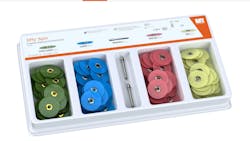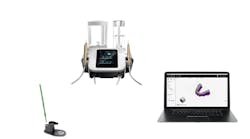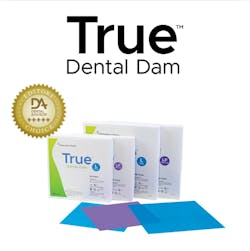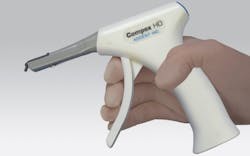Pearls for Your Practice: True Dental Dam by Clinician’s Choice, Jiffy Spin Composite Shaping and Finishing Disk Kit by Ultradent, Compex HD by AdDent
Jiffy Spin Composite Shaping and Finishing Disk Kit by Ultradent
During my restorative dentistry training, we used a lot of finishing burs to shape restorations. This makes sense for posteriors, and is still what I do today. However, my tactics have totally changed for anterior composite restorations, especially class IVs. I now do much more shaping with a disk. I still may use some burs on low speed to add some anatomy, but disks are my go-to for shaping and then polishing anteriors.
To do this well, we need a disk system that is easy to use and comes in grits for shaping, finishing, and polishing. A new entry on the market is Ultradent’s Jiffy Spin kit.
Jiffy Spin consists of four disks with different grits designed to allow you to shape, finish, and polish composite resin restorations. They fit into a latch-type handpiece on a specialized stainless-steel mandrel. This mandrel is designed so the disks can be used on either side for either a push or a pull action. This makes a big difference in shaping, especially as we move toward line angles and interproximal areas.
There are four disks in the kit. The green one is a diamond grit disk designed for rapid shaping and gross removal of excess composite. This disk is great for getting the restoration roughly in place within a minute or so. The other three in the system are all ultrathin disks that are coated with aluminum oxide. The first and “grittiest” of these is the blue disk. You can see and feel a difference in its thickness versus the green’s. It does remove composite well, but it is not nearly as aggressive as the green disk. I consider the green disk a shaping disk and the blue one a finishing disk.
The next two are polishing disks. The red disk is the second finest one in the set; it is considered medium grit and is the one I prefer to use to shape incisal embrasures. It’s not too aggressive so it doesn’t gouge, and it’s thin enough to get it where you need it. The final disk is the yellow, fine disk. It is definitely for polishing as it will do little to nothing for shaping or finishing. After I use the Jiffy disk system on the buccal of a class IV restoration, I’ll use the Jiffy Natural Composite twirls for the lingual of the restoration. These systems work well together to cover my needs for all surfaces of anterior restorations.
The Jiffy Spin disks come in both 10 mm and 14 mm sizes. Depending on the size of the tooth you are finishing and polishing, I use them anywhere between 10,000 and 20,000 RPM in my latch-type handpiece. I have my assistant periodically spray the tooth with a little air and water to cool the tooth during the process.
One of my focuses when using disks to shape, finish, and polish is to keep my pressure light. If I have to press too hard to get the desired effect, I should be using a coarser disk. Disk systems like the Jiffy Spin have allowed me to get better results faster on my class IV restorations. Line drive single back up the middle to center field for Ultradent!
True Dental Dam by Clinician’s Choice
I plead guilty—I don’t always use a rubber dam on my restorative dentistry. The problem started in dental school. Our restorative dentistry faculty required us to use a rubber dam for every restoration; not only that, it had to have isolation from the most terminal tooth on the operative side, all the way to the contralateral canine. This forced novice dental students to spend 30 to 45 minutes of frustration trying for rubber dam isolation. After two years of this, most dental students vowed never to place a rubber dam again.
In truth, we should be teaching quick, simple, and pragmatic ways to use rubber dam isolation in regular private practice. One of those should be picking the right rubber dam material. In my opinion, the best on the market is True Dental Dam by Clinician’s Choice.
True Dental Dam sets itself apart with how easy it is to stretch and apply without tearing. There is nothing more frustrating than a torn dam. That happens far less often now that I’m using True; it seems to glide through contacts much more easily than other dams, which is my least favorite part of applying the dam. Trying to coordinate holding the dam down while flossing it through contacts with an assistant—all while not hurting the patient—is a challenge, but not nearly as big of an issue with True. True Dental Dam also seems to invert more easily and stays that way throughout the procedure, minimizing leakage.
True Dental Dam offers latex and nonlatex options as well as varying sizes and gauges. You have the choice of medium and heavy gauge and sizes 5 inches by 5 inches and 6 inches by 6 inches.
I know rubber dams are not sexy. No one wakes up in the morning energized by the thought of using a rubber dam. But it can definitely make our lives easier, and picking the right material is the best first step. That choice is easy…True Dental Dam! Triple to the left field wall for Clinician’s Choice!
Compex HD by AdDent
Do you remember your first cell phone? Odds are it was not a smartphone. It was probably a brick of some sort that allowed you to do two things: make phone calls and play a weird snake game. That was it. Then, of course, the world changed in 2007 with the advent of the iPhone and modern smartphones.
Heated composite is sort of like that for me. When I have to use room-temperature composite on a posterior restoration, I feel like I have a brick cell phone again. Heated composite is all I want to use, especially in the posterior. The Compex HD by Addent is like the smartphone of composite dispensers!
Heating composite does only good things for you, especially in the posterior. The magic number for heating is 155 degrees Fahrenheit. When you hit that number, the properties of composite shift in your favor. It becomes less viscous and easier to dispense into the preparation. We get a greater depth of cure and an increase in the strength of our composite.
In addition to the greater depth, we get a reduction in the amount of curing time it takes to get the monomers to convert. These are all good things in the posterior, where that decreased viscosity allows better adaptation to the nooks and crannies of the prep. Less shrinkage. Fewer microgaps. All these things work in our favor. The problem is the actual heating of the composite. There are many tools that allow us to heat our composite compules to the requisite 155 degrees, but they can be cumbersome. The Compex HD by Addent is a slick solution that requires no forethought.
When using countertop heaters, your assistant needs to turn them on in the morning and load them with compules of composite throughout the day. Then they need to turn them off at lunch…and then turn them back on after lunch, and then make sure to turn them off at the end of the day, only to repeat the cycle the next day. It’s not a huge deal, but it requires thought and action.
The Compex HD solves that problem entirely. It is a composite dispensing gun that heats the composite up as you need it—no need for preplanning. It can heat up any compule of composite to 155 degrees in around 40 seconds! The ideal workflow for the Compex HD would be to have the dental assistant preheating the composite while the dentist applies and cures the adhesive. That way, the heated composite is ready to go when needed and the dentist doesn’t have to sit and wait for the 40 seconds’ heating. The Compex HD is cordless and rechargeable. One charge can heat around 100 compules! Charging it for around four hours once a week should be plenty.
The Compex HD makes heating composite simple and easy. No more cluttered countertops and morning and evening tasks—simply load, heat, and go! Double to deep right field for AdDent!
Editor's note: This article appeared in the March 2024 print edition of Dental Economics magazine. Dentists in North America are eligible for complimentary print subscription. Sign up here.
Joshua Austin, DDS, MAGD, is a graduate and former faculty member of the University of Texas Health Science Center at San Antonio School of Dentistry. Author of Dental Economics’ Pearls for Your Practice column, Dr. Austin lectures nationally on products, dental technology, online reputation management, and social media. He maintains a full-time restorative dentistry private practice in San Antonio, Texas. You may contact Dr. Austin at [email protected].
About the Author
Joshua Austin, DDS, MAGD
Joshua Austin, DDS, MAGD, is a graduate and former faculty member of the University of Texas Health Science Center at San Antonio School of Dentistry. Author of Dental Economics’ Pearls for Your Practice column, Dr. Austin lectures nationally on products, dental technology, online reputation management, and social media. He maintains a full-time restorative dentistry private practice in San Antonio, Texas. You may contact Dr. Austin at [email protected].
Updated June 21, 2023





